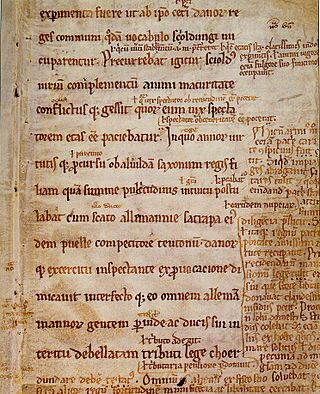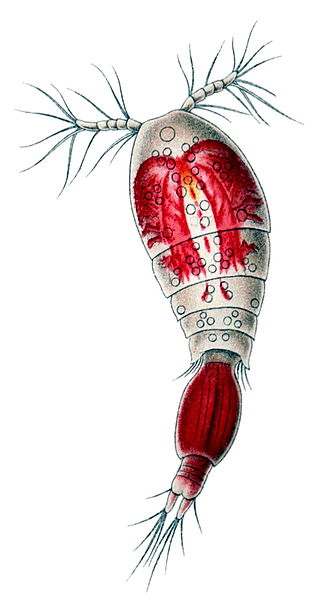
Estherville is a city in Emmet County, Iowa, United States. The population was 5,904 in the 2020 census, a decline from 6,656 at the 2000 census. It is the county seat of Emmet County.

Tantulocarida is a highly specialised group of parasitic crustaceans that consists of about 33 species, treated as a class in superclass Multicrustacea. They are typically ectoparasites that infest copepods, isopods, tanaids, amphipods and ostracods.

The Linnean Medal of the Linnean Society of London was established in 1888, and is awarded annually to alternately a botanist or a zoologist or to one of each in the same year. The medal was of gold until 1976, and is for the preceding years often referred to as "the Gold Medal of the Linnean Society", not to be confused with the official Linnean Gold Medal which is seldom awarded.

Siphonostomatoida is an order of copepods, containing around 75% of all the copepods that parasitise fishes. Their success has been linked to their possession of siphon-like mandibles and of a "frontal filament" to aid attachment to their hosts. Most are marine, but a few live in fresh water. There are 40 recognised families:
Cumoniscidae is a family of crustaceans in the class Tantulocarida, classified under the superclass Multicrustacea. The family was previously known as Deoterthridae, but Cumoniscidae was determined to be senior subjective synonym.

The Cyclopoida are an order of small crustaceans from the subclass Copepoda. Like many other copepods, members of Cyclopoida are small, planktonic animals living both in the sea and in freshwater habitats. They are capable of rapid movement. Their larval development is metamorphic, and the embryos are carried in paired or single sacs attached to first abdominal somite.
Franklin or Frank Hansen may refer to:

Cyclopidae is a family of copepods containing more than half of the 1,200 species in the order Cyclopoida in over 70 genera.

The sources of Hamlet, Prince of Denmark, a tragedy by William Shakespeare believed to have been written between 1599 and 1601, trace back as far as pre-13th century. The generic "hero-as-fool" story is so old and is expressed in the literature of so many cultures that scholars have hypothesized that it may be Indo-European in origin. A Scandinavian version of the story of Hamlet was put into writing around 1200 AD by Danish historian Saxo Grammaticus in his work Gesta Danorum. It is from this work that Shakespeare borrowed to create Hamlet. Similar accounts are found in the Icelandic Saga of Hrolf Kraki and the Roman legend of Lucius Junius Brutus, both of which feature heroes who pretend to be insane in order to get revenge. A reasonably accurate version of Saxo's story was translated into French in 1570 by François de Belleforest in his Histoires Tragiques. Belleforest embellished Saxo's text substantially, almost doubling its length, and introduced the hero's melancholy.

Oncaea is a genus of copepods. The genus contains bioluminescent species. Unlike other bioluminescent copepods, Oncaea have an internal (non-secreted) bioluminescence. Oncaea contains the following species:

This timeline of events leading to the American Civil War is a chronologically ordered list of events and issues that historians recognize as origins and causes of the American Civil War. These events are roughly divided into two periods: the first encompasses the gradual build-up over many decades of the numerous social, economic, and political issues that ultimately contributed to the war's outbreak, and the second encompasses the five-month span following the election of Abraham Lincoln as President of the United States in 1860 and culminating in the capture of Fort Sumter in April 1861.

The Bopyridae are a family of isopod crustaceans in the suborder Cymothoida. There are 1223 individual species contained in this family. Members of the family are ectoparasites of crabs and shrimp. They live in the gill cavities or under the carapace where they cause a noticeable swelling. Fossil crustaceans have occasionally been observed to have a similar characteristic bulge.
Speleophriidae is a family of copepods, comprising seven genera. All are restricted to anchialine caves, with the exception of Archimisophria, which is found in the hyperbenthos of the depths of the Atlantic Ocean. The genera are:
Choniomyzon is a genus of copepods, containing the following species: One species, C. inflatus, is a parasite of the eggs of the slipper lobster Ibacus novemdentatus.

The clade Multicrustacea constitutes the largest superclass of crustaceans, containing approximately four-fifths of all described crustacean species, including crabs, lobsters, crayfish, shrimp, krill, prawns, woodlice, barnacles, copepods, amphipods, mantis shrimp and others. The largest branch of multicrustacea is the class Malacostraca.

Eurytemora is a genus of copepods in the family Temoridae. The World Register of Marine Species lists the following species:

Arietellidae is a family of copepods belonging to the order Calanoida.
Onceroxenus is a genus of crustaceans belonging to the monotypic family Onceroxenidae.












